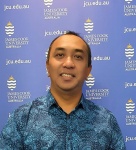

Bambang Hermanto
bambang.hermanto@my.jcu.edu.au
Recipient of an AIMS@JCU Scholarship
PhD
College of Science and Engineering

Bambang Hermanto
bambang.hermanto@my.jcu.edu.au
PhD
College of Science and Engineering
Removal of Macroalgae to Enhance Coral Cover in Degraded Reefs
Mr Hermanto completed his master’s degree program at James Cook University majoring in Marine Biology, which was sponsored by a 2-year scholarship from the Australia Award Scholarship scheme. During his studies at James Cook University, he developed relevant skills and knowledge in the areas of reef ecosystem biodiversity and benthic ecology. The experience gained from field expeditions coupled with theory classes enabled him to build his capabilities as a researcher on coral reef biodiversity and conservation. Throughout his time at JCU he also obtained extensive experience in conducting field research from marine experts.
Removal of Macroalgae to Enhance Coral Cover in Degraded Reefs
2024 to 2028
Project Description
The research project aims to quantify the effectiveness and scalability of "macroalgae removal" on a range of reef types
Project Importance
The importance of this project is understanding how the "sea-weeding" influences the dynamics of benthic communities on reefs, the patterns of coral recruitment and understanding the impact of disturbances in rehabilitation (sea weeding) area
Project Methods
Some field locations ( Magnetic island, Kepple Island etc) will be assessed for the impact of regular macroalgal removal on reef benthic communities. Data collected will be consistent across all sites to maximize the comparability of results between locations.
At each site, a robust experimental design will be implemented, and an extensive multi-year monitoring effort conducted. Briefly, all macroalgae are removed from designated replicated treatment plots while macroalgae remain in control plots. Baseline composition of benthic and fish communities within each plot will be established for all sites prior to any intervention. Changes in benthic community composition are documented using underwater photographic and in situ transect surveys before and after each macroalgae removal event.
Percent cover data are extracted from photographs using point count software (CPCe v4.1), identifying the underlying benthic organism to genus level where possible. Percent cover for each plot and time point is averaged across all photos for statistical analysis. In addition to benthic composition, a wide range of parameters will be monitored in each plot through the three years of the study, including: fish abundance and species composition (stationary point counts and cryptic crawls), algal biomass (a measure of number of holdfasts and canopy height), algal growth/regrowth rate, sediment dynamics (suspended sediments and deposition rates), water quality , and recruitment rate of juvenile corals (assessed using coral settlement tiles and monitoring visible recruits). Data will be collected for all of these parameters twice yearly.
Project Results
The project have positive impact on increasing coral cover, enhance survival rate of coral juvenile, and boost coral recruitment and reduce macro algal abundant.
Keywords
Algae,
Benthic,
Coral reefs,
Corals,
Ecology,
Field based,
Management tools,
Monitoring,
Natural disturbance